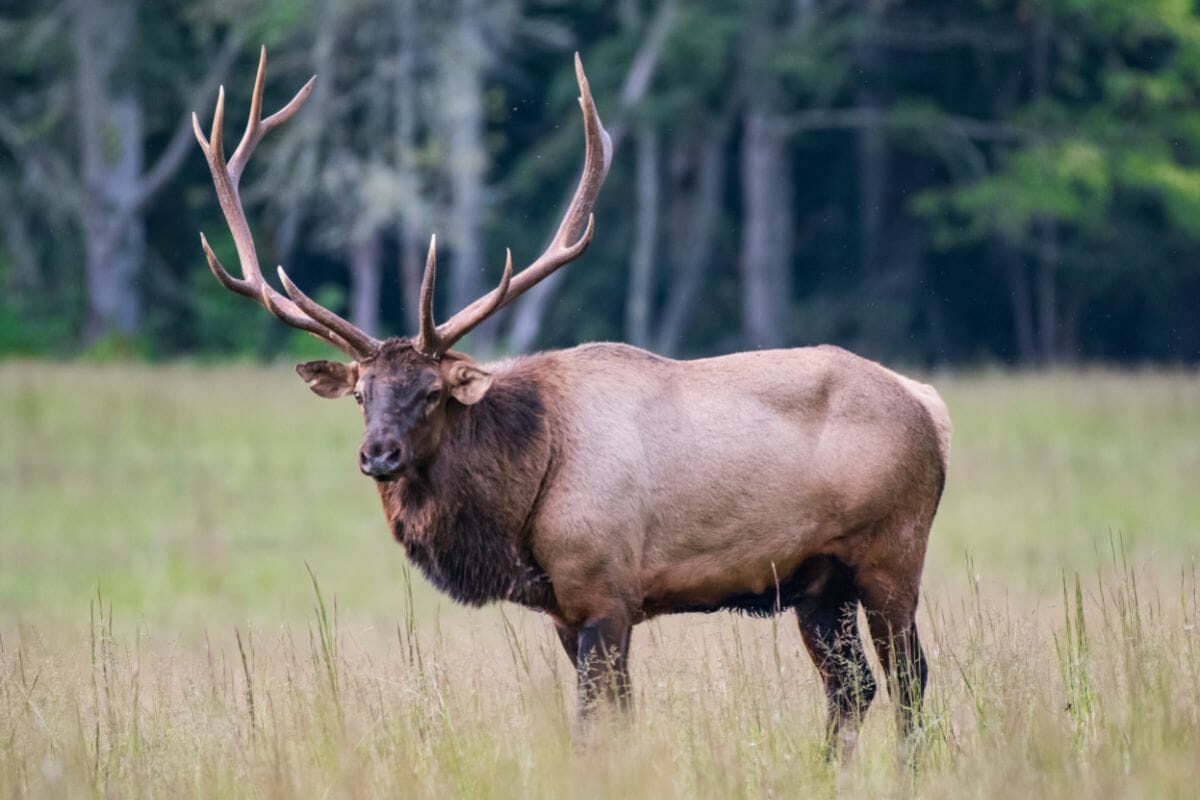Also known as the Wapiti, the elk is the largest member of the deer family, as well as one of the largest mammals on both the North American and Asian continents where it is found.
Etymology

The elk was widely respected and treasured by the Cree and Shawnee Native Americans, from whose languages came the word wapiti, meaning “white rump”.
When it comes to the word “elk”, there is some confusion depending on which side of the Atlantic you are on.
The latin name alces alces, meaning “larger deer” is used to describe a moose in North American English, but in British English, the moose is also categorized under the word elk.
However, according to the Oxford English Dictionary, the true etymology of the term “elk” is considered obscure and unknown.
Common Species Of Elk
With the elk family, there are 8 remaining common species – 4 found in North America, and 4 found in central and eastern Asia.
These include the Roosevelt’s Elk, the Tule Elk, the Manitoban Elk, the Rocky Mountain Elk, in North America, and the Altai Wapiti, the Tian Shan Wapiti, the Manchurian Wapiti, and the Alashan Wapiti in Asia, respectively.
Roosevelt’s Elk
Also known as the olympic elk, the Roosevelt Elk is the largest North American elk, based on body mass alone, although their antler sizes are smaller than other subspecies.
Named after Theodore Roosevelt in 1894 by his friend C. Hart Merriam, the Roosevelt elk, grows between 6 and 10 feet long, and around 5 and a half feet tall, with an associated weight of around 700-110 pounds in bulls, and 575-625 pounds in elk cows.
Able to live around 25 years in captivity, the lifespan of the Roosevelt elk becomes more limited in the wild, with an average of 12 to 15 years.
Between spring and fall, the Roosevelt elk feeds mainly on grasse, and in the winter months, they feed mainly on woody plants, such as elderberries.
Tule Elk
Found in California, the tule elk is a subspecies of elk found in the grasslands, and around the coast.
Named after the tule plant, the tule elk was widely hunted and almost became endangered during the European settlement of the west by 1870, but after a breeding pair were located in California, conservation efforts were made to repopulate the species.

The smallest of all the subspecies, average males only achieve a weight of around 550 pounds, whilst average females only reach around 425 pounds at a maximum.
They are also around half the size of the Roosevelt elk, which led to them being referred to as the dwarf elk in some circles.
Tule elks generally feed on grasses and sedges in their habitats.
Manitoban Elk
Found both in North America (in North Dakota) and the Canadian prairies (including Manitoba, Saskatchewan, and Northern Alberta), the Manitoban elk is larger than some species, but possesses small antlers.
In terms of weight, adult males reach weights of 1085 pounds (in some cases), and average females reside around the 600 pound range.
As a non-migrating species, the Manitoban elks are widely preyed upon by the gray wolf, an occurrence that is increased by their lack of movement.
The Rocky Mountain Elk
Found in the Rocky Mountains, and the surrounding plains, the Rocky Mountain elk has undergone widespread conservation efforts across North America, with groups established in Kentucky, Nebraska, Colorado, Washington, West Virginia, and some parts of Canada.
Smaller in size than the Manitoban elk, but with larger antlers, the Rocky Mountain elk favors open forests and floodplain marshlands, as well as the mountain habitat suggested in its name.
Altai Wapiti
Found in the foothills of southern Siberia, parts of northwestern Mongolia, and in the Xinjiang province of China, the altai wapiti is a small, pale subspecies of elk which was first classified in 1777 by Johann Christian Polycarp Erxleban.
Tian Shan Wapiti
Found in the Tian Shan mountains of Kyrgyzstan, southeastern Kazakhstan, and Xinjiang in China, the Tian Shan wapiti is the largest subspecies of Asian elk, both in relation to body mass, and the size of its antlers.
Despite widespread conservation efforts throughout Asia, their populations are rapidly decreasing as a result of widespread industrialization through formerly rural areas, as well as other problems throughout the region.

Manchurian Wapiti
One of the smallest subspecies of elk, the Manchurian wapiti, with smaller, less developed antlers, and a shorter snout.
Found throughout Siberia, Manchuria, Mongolia, North Korea, and northwestern China, females can reach a maximum weight of 474 pounds, whilst males have been known to reach 770 pounds.
Alashan Wapiti
Found in northern China and Mongolia, the Alashan wapiti is the smallest of all the subspecies of elk, has the palest fur, and has had the least studies conducted upon it, leading to a relative air of ambiguity and mystery around the breed.
Extinct Breeds
Over the last few hundred years, several species of elk have gone extinct through over-hunting and changes to the American landscape due to the arrival of European settlers.
Merriam’s Elk
One subspecies is the Merriam’s Elk, which was officially classified as extinct around 1906.
This was due to uncontrolled hunting, extensive cattle grazing across former elk feeding grounds, and the arrival of more and more settlers.
Eastern Elk
Another subspecies that fell into extinction was the eastern elk, which was officially classified as such in 1880, however it is thought that the last eastern elk was actually shot in 1777 in Pennsylvania.
This subspecies once roamed the continent for over 2500 years, making its extinction all the more poignant.
Final Thoughts
And there we have it, everything you need to know about the different species of elk found in North America and Asia.
Despite being shy and skittish creatures, many people regularly spot them every year. Who knows, maybe you’ll get the chance too?
- What Should I Do If A Koala Bites Me? Safety Guide - 2024-05-30
- Are Kangaroos Born Without Hind Legs? A Fascinating Journey - 2024-05-30
- Animals That Look Like Squirrels - 2024-05-30








